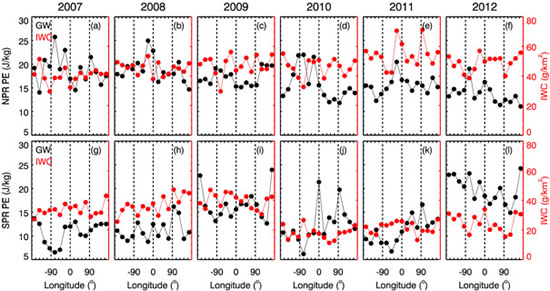|
STATUS:
08.14.2014
Instrument Status
SOFIE:
Correlations between GW PE and IWC revealed from SOFIE observations
A six-years (2007-2013) temperature dataset from the Solar Occultation for Ice Experiment (SOFIE) onboard the Aeronomy of Ice in the Mesosphere (AIM) satellite is used to extract gravity waves (GWs) in the polar stratosphere and mesosphere of both hemispheres [Liu et a., 2014]. The GW climatologies derived from SOFIE observations are consistent with previous ground and satellite observations in the polar region. Combining with the observations of the column ice water content (IWC, an indicator of the polar mesosphere cloud) by SOFIE, we find that the correlations between GW potential energy (PE) and IWC exhibit longitudinal and annual variations (see the figure). This is because a necessary condition of forming ice is low temperature. GW PE is proportional to the square of the temperature perturbation induced by GW. Both the positive and negative temperature perturbation can induce large GW PE. In contrast, only negative temperature perturbation induces lower total temperature (sum of perturbation temperature and background temperature) and provides a favorable condition for forming ice. The positive temperature perturbation induces hotter total temperature and destroys ice. The longitudinal and annual dependency of the correlations between GW PE and IWC can be used to explain the different correlations between GW and PMC revealed from previous ground-based observations.

Figure. Longitudinal variations of (black, left axis) PE averaged over the height range of 82-85 km and the (red, right axis) column ice water content (IWC).
|
